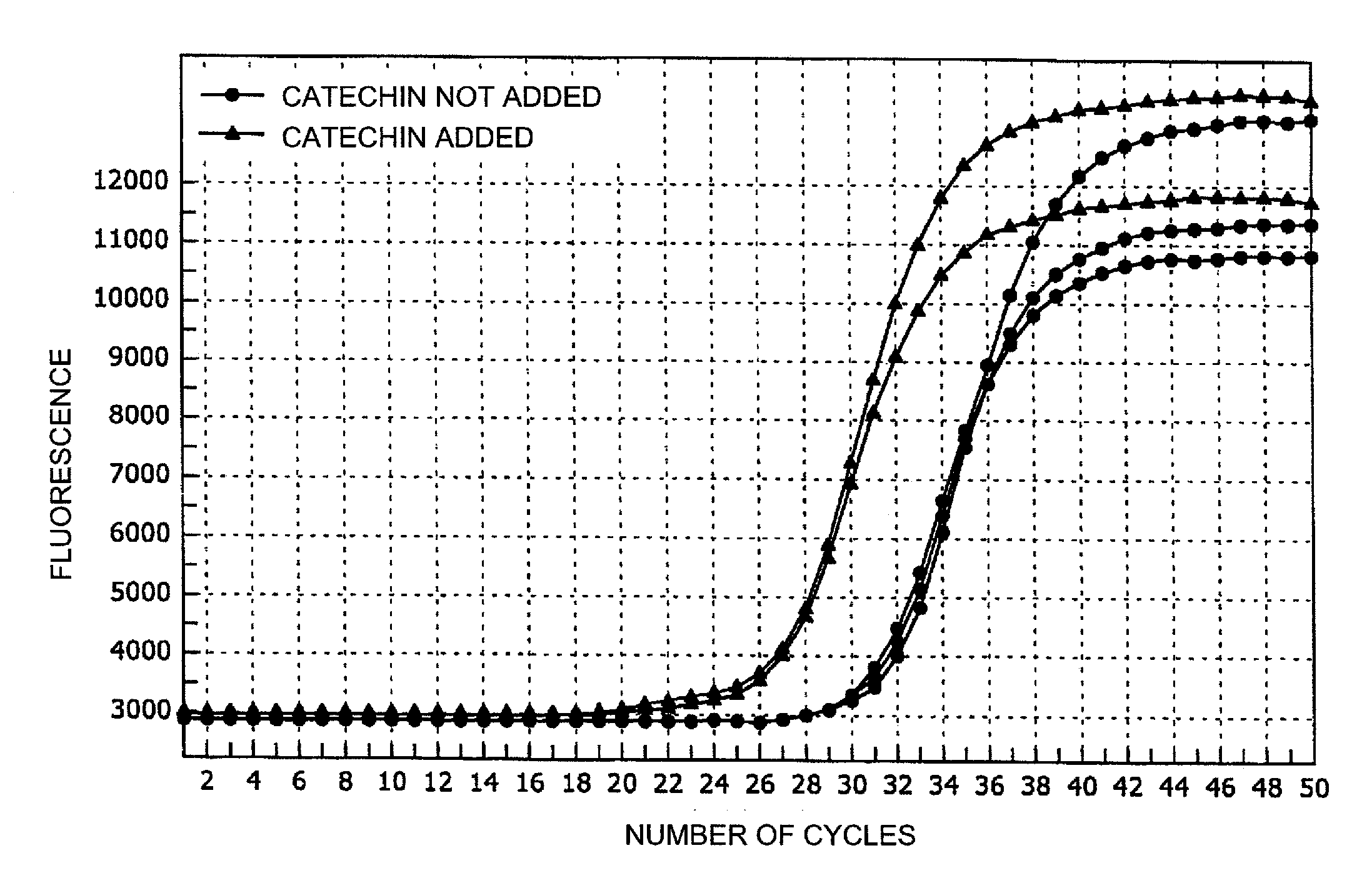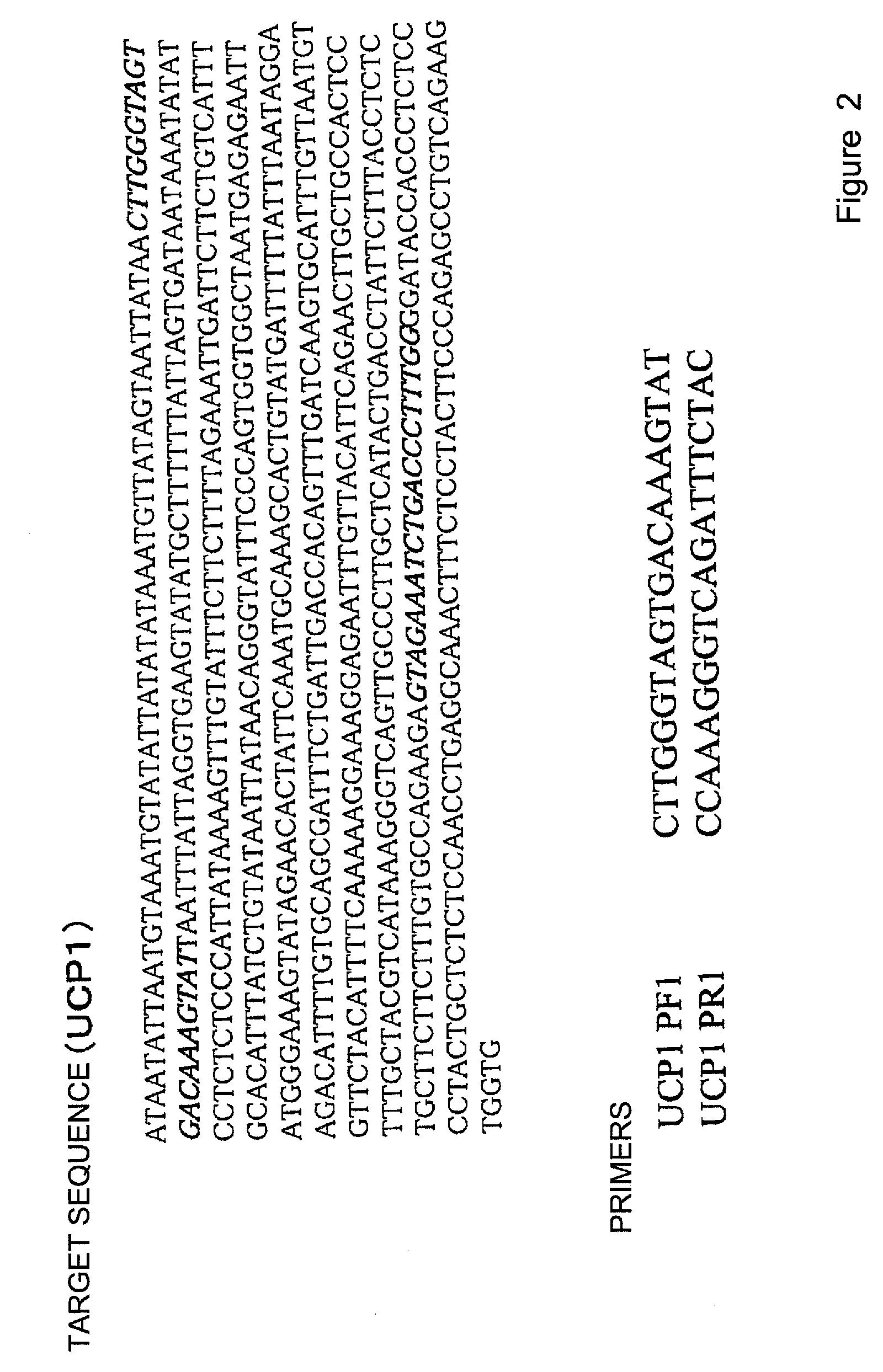Method for detecting and amplifying nucleic acid
a nucleic acid and amplification technology, applied in the field of nucleic acid detection and amplification reactions, can solve the problems of difficult to remove impurities completely from some biological samples, time and labor, and inability to quantitatively detect nucleic acid, etc., to achieve accurate detection and/or amplification, increase the chance of contamination, and facilitate the effect of processing
- Summary
- Abstract
- Description
- Claims
- Application Information
AI Technical Summary
Benefits of technology
Problems solved by technology
Method used
Image
Examples
example 1
Effect of Additives in SMAP Method and PCR Method
[0058]In this example, oral mucosal cells were used as a biological sample, and a target nucleic acid sequence in the human CYP2D6 gene contained therein was amplified by the SMAP method (MITANI method), or a target nucleic acid sequence in the UCP1 gene was amplified by a PCR method to examine improvement of amplification effects of various additives. Tannic acid was added in the SMAP method, and sodium glucuronate was added in the PCR method.
[0059]As primers in the SMAP method, a primer set having the following sequences (2D6*44-F1 and 2D6*44-SR2 [SEQ ID NOS: 1 and 2, respectively]) was used. Furthermore, positions of the primer regions corresponding to a template (SEQ ID NO: 3) are shown in FIG. 1. Unless otherwise specified, primer sequences and the like are written with the left hand side as the 5′ side and the right hand side as the 3′ side in the present specification.
[0060]The forward primer 2D6*44-F1 was designed so that a se...
example 2
Effect of Additives by SMAP Method
[0066]In this example, blood was used as a biological sample, and improvement of effect of amplifying a target nucleic acid sequence (SEQ ID NO: 10) in the human CYP2C19 gene contained therein by the SMAP method (MITANI method) after adding a surfactant in alkali treatment of blood.
[0067]As primers for the SMAP method, a primer set having the following sequences (CYP2C19-2 [SEQ ID NOS: 11 to 15]) was used. Furthermore, the positions of the primer regions corresponding to the template are shown in FIG. 5.
[0068]The forward primer CYP2C19*2FP was designed so that a sequence existing on the 3′ side (25mer: the underlined region in the following sequence) should be annealed with the template, and that a sequence existing on the 5′ side (16mer: other than the underlined region in the following sequence) should loop back at the 8th nucleotide from the 5′ end to form a hairpin structure.
[0069]CYP2C19-2 TP(W) was designed so that a sequence existing on the 3...
example 3
Effect of Additive and Heating on Nucleic Acid Amplification by SMAP Method
[0074]In this example, human whole blood was used as a biological sample, and a target nucleic acid sequence in the human CYP2D6 gene contained therein was amplified. The same primers as used in Example 1 were used. The reaction conditions and the like were the same as in Example 1.
[0075]25 μL of a reaction mixture was prepared. The composition of the reaction mixture was the same as that of the reagents used in the SMAP method of Example 1, except that blood was used as a sample containing DNA used as a template, and chlorogenic acid was used as an additive.
[0076]In heat treatment of the sample, 6 μL of EDTA (25 mM) was added to 3 μL of the collected blood, and the mixture was dissolved and homogenized, followed by addition of 1 μL of 5 mM chlorogenic acid. 10 μL of this solution was heated at 98° C. for 3 minutes. After amplification, it was confirmed by DNA sequencing that the amplification product was the...
PUM
| Property | Measurement | Unit |
|---|---|---|
| temperature | aaaaa | aaaaa |
| temperature | aaaaa | aaaaa |
| temperature | aaaaa | aaaaa |
Abstract
Description
Claims
Application Information
 Login to View More
Login to View More - R&D
- Intellectual Property
- Life Sciences
- Materials
- Tech Scout
- Unparalleled Data Quality
- Higher Quality Content
- 60% Fewer Hallucinations
Browse by: Latest US Patents, China's latest patents, Technical Efficacy Thesaurus, Application Domain, Technology Topic, Popular Technical Reports.
© 2025 PatSnap. All rights reserved.Legal|Privacy policy|Modern Slavery Act Transparency Statement|Sitemap|About US| Contact US: help@patsnap.com



